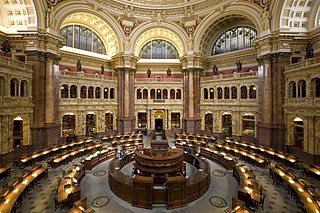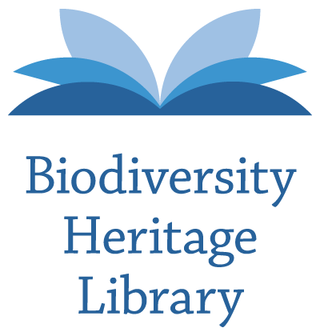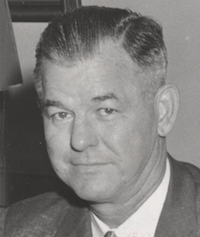Related Research Articles

Digitization is the process of converting information into a digital format. The result is the representation of an object, image, sound, document, or signal obtained by generating a series of numbers that describe a discrete set of points or samples. The result is called digital representation or, more specifically, a digital image, for the object, and digital form, for the signal. In modern practice, the digitized data is in the form of binary numbers, which facilitates processing by digital computers and other operations, but digitizing simply means "the conversion of analog source material into a numerical format"; the decimal or any other number system can be used instead.

A research library is a library that contains an in-depth collection of material on one or several subjects. A research library will generally include an in-depth selection of materials on a particular topic or set of topics and contain primary sources as well as secondary sources. Research libraries are established to meet research needs and, as such, are stocked with authentic materials with quality content. Research libraries are typically attached to academic or research institutions that specialize in that topic and serve members of that institution. Large university libraries are considered research libraries, and often contain many specialized branch research libraries. The libraries provide research materials for students and staff of these organizations to use and can also publish and carry literature produced by these institutions and make them available to others. Research libraries could also be accessible to members of the public who wish to gain in-depth knowledge on that particular topic.
The California Digital Library (CDL) was founded by the University of California in 1997. Under the leadership of then UC President Richard C. Atkinson, the CDL's original mission was to forge a better system for scholarly information management and improved support for teaching and research. In collaboration with the ten University of California Libraries and other partners, CDL assembled one of the world's largest digital research libraries. CDL facilitates the licensing of online materials and develops shared services used throughout the UC system. Building on the foundations of the Melvyl Catalog, CDL has developed one of the largest online library catalogs in the country and works in partnership with the UC campuses to bring the treasures of California's libraries, museums, and cultural heritage organizations to the world. CDL continues to explore how services such as digital curation, scholarly publishing, archiving and preservation support research throughout the information lifecycle.

Verner Warren Clapp was a librarian, writer, and polymath.

In conservation, library and archival science, preservation is a set of preventive conservation activities aimed at prolonging the life of a record, book, or object while making as few changes as possible. Preservation activities vary widely and may include monitoring the condition of items, maintaining the temperature and humidity in collection storage areas, writing a plan in case of emergencies, digitizing items, writing relevant metadata, and increasing accessibility. Preservation, in this definition, is practiced in a library or an archive by a conservator, librarian, archivist, or other professional when they perceive a collection or record is in need of maintenance.
The Brittle Books Program is an initiative carried out by the National Endowment for the Humanities at the request of the United States Congress. The initiative began officially between 1988 and 1989 with the intention to involve the eventual microfilming of over 3 million endangered volumes.

The Biodiversity Heritage Library (BHL) is the world’s largest open access digital library for biodiversity literature and archives. BHL operates as a worldwide consortium of natural history, botanical, research, and national libraries working together to address this challenge by digitizing the natural history literature held in their collections and making it freely available for open access as part of a global "biodiversity community". The BHL consortium works with the international taxonomic community, publishers, bioinformaticians, and information technology professionals to develop tools and services to facilitate greater access, interoperability, and reuse of content and data. BHL provides a range of services, data exports, and APIs to allow users to download content, harvest source data files, and reuse materials for research purposes. Through taxonomic intelligence tools developed by Global Names Architecture, BHL indexes the taxonomic names throughout the collection, allowing researchers to locate publications about specific taxa. In partnership with the Internet Archive and through local digitization efforts, BHL's portal provides free access to hundreds of thousands of volumes, comprising over 59 million pages, from the 15th-21st centuries.
Patricia Meyer Battin was one of the first librarians in the United States to combine the responsibilities of library administrator and technology director. Her focus shifted toward preservation when she became the first president of the Commission on Preservation and Access. She later became a pioneer in the digital library movement and began to work in the area of digital preservation.
Digital artifactual value, a preservation term, is the intrinsic value of a digital object, rather than the informational content of the object. Though standards are lacking, born-digital objects and digital representations of physical objects may have a value attributed to them as artifacts.
Music librarianship is the area of librarianship that pertains to music collections and their development, cataloging, preservation and maintenance, as well as reference issues connected with musical works and music literature. Music librarians often have degrees in both music and librarianship. Music librarians deal with standard librarianship duties such as cataloging and reference, which become more complicated when music scores and recordings are involved. Therefore, music librarians generally read music and have at least a basic understanding of both music theory and music history to aid in their duties.
Digital Collections Selection Criteria are applied by organisations creating a digital library which of their existing holdings and forthcoming acquisitions to digitize for inclusion.

The Digital Library Federation (DLF) is a program of the Council on Library and Information Resources (CLIR) that brings together a consortium of college and university libraries, public libraries, museums, and related institutions with the stated mission of "advanc[ing] research, learning, social justice, and the public good through digital library technologies." It was formed in 1995.

Smithsonian Libraries and Archives is an institutional archives and library system comprising 21 branch libraries serving the various Smithsonian Institution museums and research centers. The Libraries and Archives serve Smithsonian Institution staff as well as the scholarly community and general public with information and reference support. Its collections number nearly 3 million volumes including 50,000 rare books and manuscripts.

GLAM is an acronym for galleries, libraries, archives, and museums, and refers to cultural institutions with a mission to provide access to knowledge. GLAMs collect and maintain cultural heritage materials in the public interest. As collecting institutions, GLAMs preserve and make accessible primary sources valuable for researchers.
The HBCU Library Alliance is a consortium of libraries at Historically Black Colleges and Universities (HBCUs). Founded in 2002 by deans and directors of libraries at HBCUs, the consortium comprises over 100 member organizations. The alliance specifically represents the organizations included in the White House HBCU Initiative. In 2019 the HBCU Library Alliance entered into a national partnership with the Council on Library and Information Resources.

Fred Carrington Cole was an American librarian and historian. He was president of the Council on Library Resources and Washington and Lee University. In 1999, American Libraries named him one of the "100 Most Important Leaders We Had in the 20th Century".
The Anton Brees Carillon Library, located within the Singing Tower at Bok Tower Gardens, Lake Wales, Florida, is home to various collections that document the history and development of the Singing Tower and its gardens, the historic Pinewood Estate, and The Guild of Carillonneurs in North America. It also contains many sources on carillon art in general.

Deanna Bowling Marcum was an American librarian and nonprofit leader who served as president of the Council on Library and Information Resources from 1995 to 2003, Associate Librarian for Library Services at the Library of Congress from 2003 to 2011, and managing director of Ithaka S+R from 2012 to 2016.
The Kurdish Heritage Institute is a non-governmental organization for preserving Kurdish heritage and music based in Sulaymaniyah, Iraq.

Michael Alan Keller is an American academician and librarian. He holds an appointment at Stanford University as the Ida M. Green University Librarian and, until August 31, 2020, Vice Provost for Teaching and Learning (2018-2020).
References
- ↑ "Sponsors, Members, and Funders". clir.org.
- ↑ "Financials". clir.org. Archived from the original on 2016-08-26. Retrieved 2017-02-01.
- ↑ "Council on Library and Information Resources". USA: Society of American Archivists . Retrieved 17 January 2013.
- ↑ "Sponsors, Members, and Funders • CLIR". CLIR. Retrieved 2018-03-21.
- ↑ "Governance • CLIR". CLIR. Retrieved 2018-03-21.
- ↑ "DLF Advisory Committee – DLF". DLF. Retrieved 2018-03-21.
- ↑ "Hidden Collections • CLIR". CLIR. Retrieved 2018-03-21.
- ↑ "Andrew W. Mellon Foundation provides $4,415,000 to support CLIR's Digitizing Hidden Special Collections and Archives: Amplifying Unheard Voices". Backstage Library Works. February 19, 2021. Archived from the original on February 19, 2021. Retrieved January 22, 2023.
- ↑ Price, Gary (April 28, 2022). "Council on Library and Information Resources (CLIR) Announces Digitizing Hidden Collections: Amplifying Unheard Voices Awards". Library Journal. Archived from the original on May 9, 2022. Retrieved January 22, 2023.
- ↑ "Digitizing Hidden Special Collections and Archives". Moving Image Archive News. January 9, 2020. Archived from the original on January 24, 2020. Retrieved January 22, 2023.
- ↑ "Grant provided by CLIR".
- ↑ "CLIR Postdoctoral Fellowship Program • CLIR". CLIR. Retrieved 2018-03-21.
- ↑ "Mellon Fellowships for Dissertation Research in Original Sources • CLIR". CLIR. Retrieved 2018-03-21.
- ↑ "Leading Change Institute". www.leadingchangeinstitute.org.
- ↑ "— Coherence Website". coherence.clir.org.
- ↑ "CLIR Reports • CLIR". CLIR. Retrieved 2018-03-21.
- ↑ "Council on Library and Information Resources, USA". Digital Preservation Europe. Archived from the original on 10 December 2011. Retrieved 17 January 2013.
- 1 2 "History – Library of Congress Information Bulletin 62(9), p. 199". Council on Library and Information Resources. Retrieved 19 April 2015.
- ↑ "Marcum Appointed Associate Librarian for Library Services". Library of Congress . September 2003. Retrieved 19 April 2015.
- ↑ "The Council on Library Resources" (1961). Bulletin of the Medical Library Association, 49(2), p. 225.
- ↑ Marcum, Deanna B. (March 31, 1995). "Reclaiming the Research Library: The Founding of the Council on Library Resources." Paper presented at the Library History Seminar, Tuscaloosa, Alabama. 22 pages; here: p. 2 ff. Retrieved 26 April 2015 from http://www.clir.org/about/history/
- ↑ Hallstein, Ann L. (1985). "Clapp, Verner W." In Allen Kent (Ed.), Encyclopedia of Library and Information Science, 39, supplement 4, p. 79-86; here: p. 79, 85–86.
- ↑ Rosenberg, Jane (1985). "Council on Library Resources." In Allen Kent (Ed.), Encyclopedia of Library and Information Science, 39, supplement 4, p. 86-98; here: p. 87.
- ↑ Hallstein (1985), p. 85.
- ↑ Rosenberg (1985), p. 88-92.
- ↑ Marcum, Deanna B. (1988). "President, Council on Library Resources." In Martin M. Cummings (Ed.), Influencing Change in Research Librarianship: A Festschrift for Warren J. Haas. Washington, DC: Council on Library Resources. p. 9-20; here: p. 11-12. Retrieved 27 April 2015.
- ↑ Marcum (1988), p. 12.